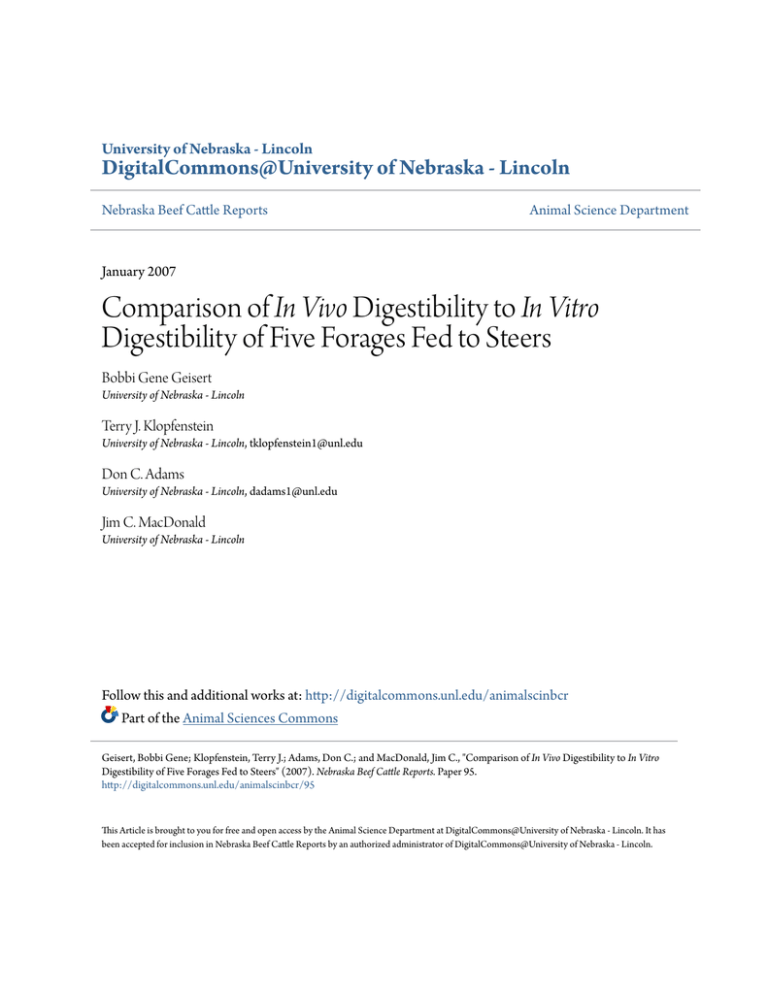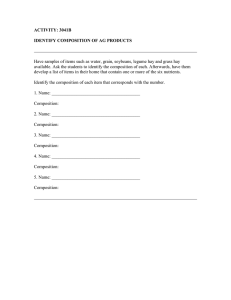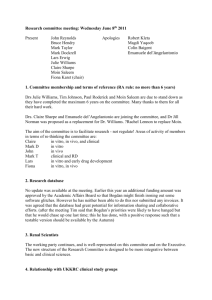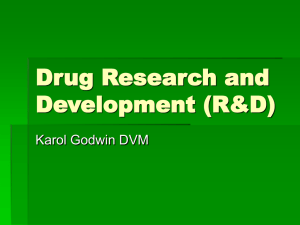
University of Nebraska - Lincoln
DigitalCommons@University of Nebraska - Lincoln
Nebraska Beef Cattle Reports
Animal Science Department
January 2007
Comparison of In Vivo Digestibility to In Vitro
Digestibility of Five Forages Fed to Steers
Bobbi Gene Geisert
University of Nebraska - Lincoln
Terry J. Klopfenstein
University of Nebraska - Lincoln, tklopfenstein1@unl.edu
Don C. Adams
University of Nebraska - Lincoln, dadams1@unl.edu
Jim C. MacDonald
University of Nebraska - Lincoln
Follow this and additional works at: http://digitalcommons.unl.edu/animalscinbcr
Part of the Animal Sciences Commons
Geisert, Bobbi Gene; Klopfenstein, Terry J.; Adams, Don C.; and MacDonald, Jim C., "Comparison of In Vivo Digestibility to In Vitro
Digestibility of Five Forages Fed to Steers" (2007). Nebraska Beef Cattle Reports. Paper 95.
http://digitalcommons.unl.edu/animalscinbcr/95
This Article is brought to you for free and open access by the Animal Science Department at DigitalCommons@University of Nebraska - Lincoln. It has
been accepted for inclusion in Nebraska Beef Cattle Reports by an authorized administrator of DigitalCommons@University of Nebraska - Lincoln.
Comparison of In Vivo Digestibility to In Vitro Digestibility
of Five Forages Fed to Steers
Bobbi Gene Geisert
Terry J. Klopfenstein
Don C. Adams
Jim C. MacDonald1
Summary
Eight crossbred yearling steers were
used in a Latin rectangle design to determine the in vivo digestibility of five
different forages. Feed intakes were higher
when steers were fed forages with higher
IVDMD. In vivo digestibility of the hay
used in this trial was highly correlated to
in vitro digestibility. On average, in vitro
DMD was 5.4 percentage units higher
than in vivo digestibility. Including these
five hay samples as standards for in vitro
analysis allows researchers to compare
samples analyzed across in vitro runs. It
also allows researchers to adjust the in vitro DMD to in vivo DMD, which allows­
for more accurate ration formulation and
animal response prediction.
Introduction
Previous research indicates
in vitro DMD of forages is highly
correlated with in vivo digestibility.
Including a set of samples within
each in vitro run which has known in
vivo digestibilities allows researchers to adjust­ in vitro digestibility of
forages to in vivo values using regression equations generated from the
standards. It has been shown that the
regression equations differ within
plant type (C3, C4 and legumes)
and the same samples run in different laboratories also differ. This
is due to a number of factors which
include donor animals, diets fed to
donor animals, and differences in
analytical techniques. In vitro runs
analyzed in different runs cannot
be compared equally because of run
variability. Adjusting the in vitro results using the equations generated
from the standards (with known in
vivo digestibility­) allows researchers
to compare estimates from different in vitro runs. With these adjustments, forage samples with different
species composition, such as grasses
vs. legumes­, can also be compared
because­ each sample has been
adjusted­ accordingly. The objective of
this experiment was to determine the
in vivo digestibility of five different
hay samples and to use these samples
as standards in in vitro DM digestibility procedures and make comparisons between in vivo and in vitro
digestibility. ­
Proceedure
This experiment used eight crossbred yearlings in a 5x5 Latin rectangle
with five periods and five diets. Diets
consisted of five chopped hays including mature brome grass (MBrome),
immature brome grass (IBrome),
mature­ alfalfa (MAlf), immature
alfalfa­ (IAlf), and prairie (Prairie).
Prairie hay consisted of a mixture
of warm season grasses. All hay was
chopped on one day, through a 4 inch
screen using a tub grinder at the beginning of the trial, mixed, and stored
on concrete in an enclosed building.
Periods­ consisted of a 16-day adaptation period followed by a five-day collection period. During the adaptation
period steers were fed at ad libitum
intake for the first 10 days.
The following six days steers were
fed at 95 % of ad libitum intake to
minimize feed refusals and reduce
variation in measurements of digestion. Steers remained on the restricted
DMI throughout the collection
period. Steers initially weighed 710
lbs and gained an average of 55 lbs
throughout the trial.
Hay samples were taken daily during the last eight days of each period,
composited and a sub-sampled for
lab analysis. If necessary feed refusals
were also collected the last eight days
© The Board of Regents of the University of Nebraska. All rights reserved.
of each period for analysis. Steers were
fitted with fecal collection bags during
the collection period to measure total
fecal output. Bags were emptied and
feces weighed and sub-sampled twice
daily (7:00 am and 4:00 pm). All feed
samples and fecal samples were dried
in a 60°C forced air oven and ground
through a Wiley mill (1mm screen)
for analysis.
In Vitro dry matter digestibility
(IVDMD) analysis was conducted on
the five hay samples and replicated
six times. The IVDMD values from
each run were regressed against the
in vivo DMD. The slopes of each
regression­ line were compared. Differences between­ regression equations were also tested. Total protein
was determined as well as degradable
intake protein (DIP) and undegradable intake protein (UIP) using in situ
mobile bag technique (2005 Nebraska
Beef Report, pp. 25-27) using two
ruminally and duodenally fistulated
Holstein steers.
Results
In Vitro
Crude protein of the diets were 7.9,
7.5, 9.3, 16.3, and 17.6% for Prairie,
MBrome, IBrome, MAlf, and IAlf,
respectively­ (Table 1). UIP ranged from
10.1% (% of total CP) for IAlf to 37.2
% for the MBrome (Table 1). Total
Tract indigestible protein (TTIDP)
follows the same pattern as the UIP
(5.0, 8.0, 14.8, 15.3, and 16.6 for IAlf,
Malf, IBrome, MBrome, and Prairie,
respectively). Digestibility of UIP fraction was highest for MAlf (62.4%)
and lowest for IBrome (34.0%). UIP
digestibility of these forages are lower
than the NRC assumed 80%. These
UIP digestibilities agree with results
from Haugen et al., (2005 Nebraska
Beef Report, pp. 25-27) who reported
UIP digestibilities lower than the NRC
(Continued on next page)
2007 Nebraska Beef Report — Page 109
In Vivo
In vivo DM digestibility was significantly higher (P<0.001)for the IBrome
and the IAlf (62.2 and 66.5%, respectively) compared to the other three
hays (56.5, 58.1, and 55.5% for MAlf,
MBrome, and Prairie, respectively)
(Table 2). There were no differences
(P=0.74) between the Prairie, MBrome,
and the MAlf hay. Organic matter
digestibilit­y followed the same pattern
as DMD, with IBrome and IAlf having greater (P<0.001) digestibility than
the other three hays. Neutral detergent
fiber­ digestibility followed the same
pattern as DMD and OMD. There were
no differences between IBrome and
IAlf, but they were significantly higher
than Prairie, MBrome, and MAlf.
Regression analysis indicated no
significant difference (P=0.99) between­
the slopes of the regression lines
(Figure­ 1). However, there was a difference (P=0.04) between the six different
runs. This difference between the runs
demonstrates the need for standards
to adjust in vitro values in order make
comparisons to in vivo digestibility and
between different forages. The differences between the in vitro runs could
be attributed­ to rumen fluid from
Page 110 — 2007 Nebraska Beef Report Table 1. Chemical composition of the experimental hays.
Variable Prairie CP, %
IVDMD, %
NDF, % ADF,%
UIP, % TTIDP, %e UIPD,%f
7.9
52.8 68.3 43.4
27.9 16.6 40.1 MAlfa
Diet
MBromeb IBromec IAlfd
16.3
7.5
9.3
17.6
58.6
54.5
60.1 67.1
67.9 69.6 66.7 60.5
43.7
43.7
40.035.2
14.9 37.2 22.6 10.1
8.0 15.3 14.8 5.0
62.4 58.9 34.0 46.0
aMean Mature Alfalfa Hay
bMeans Mature Brome Grass Hay
cMeans Immature Brome Grass Hay
dMeans Immature Alfalfa Hay
eTotal tract Indigestible Protein
f Lower tract UIP Digestibility
Table 2. In Vivo and In Vitro digestibility of five different hays fed to yearling steers.
Diet
Variable
Prairie
MAlf1
MBrome2
Statistics
IBrome3
IAlf4
SEM
P-value
In Vivo
DMI, lb
DMD, % OMD, % NDFD, % 11.9ce 50.2cf 55.5be 47.1cf 14.7ad 50.9ad 56.5ac 47.0ad 13.0be 51.2be 58.1d 45.2be 13.6abc 56.4abc 62.2ab 57.0abc 16.1d 60.6def 66.5cde 53.7def 0.6
1.6 1.4 2.3 <0.01
<0.01
<0.01
<0.01
In Vitro
DMD, % OMD, % NDFD, % 52.8be 49.8acd
43.8bd 52.9ac
54.5b
43.4ac
53.9d
57.9c
48.6
59.1ab 62.4a
54.0ab 63.9cde
64.2bd
51.5cd
1.6
2.0
1.6
0.02
0.03
0.03
1Mean Mature Alfalfa Hay
2Means Mature Brome Grass Hay
3Means Immature Brome Grass Hay
4Means Immature Alfalfa Hay
abcdef Means with like superscripts differ
80
significantly (P<0.001)
y = 0.8574x + 12.175
R2 = 0.7738
70
y = 0.8215x + 10.637
R2 = 0.985
60
In Vitro DMD, %
estimates. There was a wide range in
IVDMD between the different hays as
well (50.2, 51.2, 56.4, 50.9, and 60.6 %
for Prairie, MBrome, IBrome, MAlf,
and IAlf, respectively). As digestibility of the hay increased so did DMI
(P<0.001; Table 1). Intakes were highest
when steers were fed either of the alfalfa hays and lowest when fed mature
grass hay. There were no differences in
intake within the three grass hays or
within the two alfalfa hays. This would
be expected as it is well documented
that cattle intakes increase when fed
a highly digestible forage (Figure 1)
compared to forages that are lower
in digestibility, presumably, due to
increased­ rate of passage.
In vitro DMD and OMD were
higher for IAlf than the other four
hays (Table 2). Unlike the in vivo
DMD data, the IBrome hay was similar
(P>0.05) to the MBrome and the MAlf
and Prairie was similar to the IAlf hay.
y = 0.9941x + 4.97355
R2 = 0.7539
50
y = 1.0228x + 4.8513
R2 = 0.8401
40
y = 0.892x + 15.25
R2 = 0.798
30
y = 1.0458x + 2.3394
R2 = 0.6785
20
10
0
0
10
2030
40
50
60
70
80
In Vivo DMD, %
Figure 1. Regression analysis of in vivo vs. in vitro digestibility.
© The Board of Regents of the University of Nebraska. All rights reserved.
donor animals, differences in technicians, and the handling of rumen fluid
prior placing in the tubes. However,
in vitro (test tube) and in vivo (in the
animal) digestibilities had good agreement, and were significantly correlated
(r = 0.82 to 0.99). When the six runs
were averaged (Figure 2) together IVDMD was 5.4 percentage units higher
than in vivo DMD. This equates to an
8% difference between in vivo and in
vitro digestibility.
80
70
y = 0.9406x + 8.3709
R2 = 0.9004
In Vitro DMD, %
60
50
40
30
Implications
20
10
0
0
10
2030
40
50
60
70
80
In Vivo DMD, %
Figure 2. Regression analysis of the average of all six in vitro runs. Each point represents the average of each of the five different hay samples.
Including these five hay samples
with in vitro DMD analyse as standards
will allow prediction of in vivo digestibility for new forages. This is important in research settings where a large
number of samples are collected and
cannot be included within the same
in vitro run. Samples can be analyzed
at different times and the adjustment
allows­ us to compare different runs.
1Bobbi Gene Geisert, graduate student;
Terry J. Klopfenstein, professor, Animal Science,
Lincoln; Don C. Adams, director, WCREC North
Platte; Jim C. MacDonald, research technician,
Animal Science, Lincoln.
© The Board of Regents of the University of Nebraska. All rights reserved.
2007 Nebraska Beef Report — Page 111




